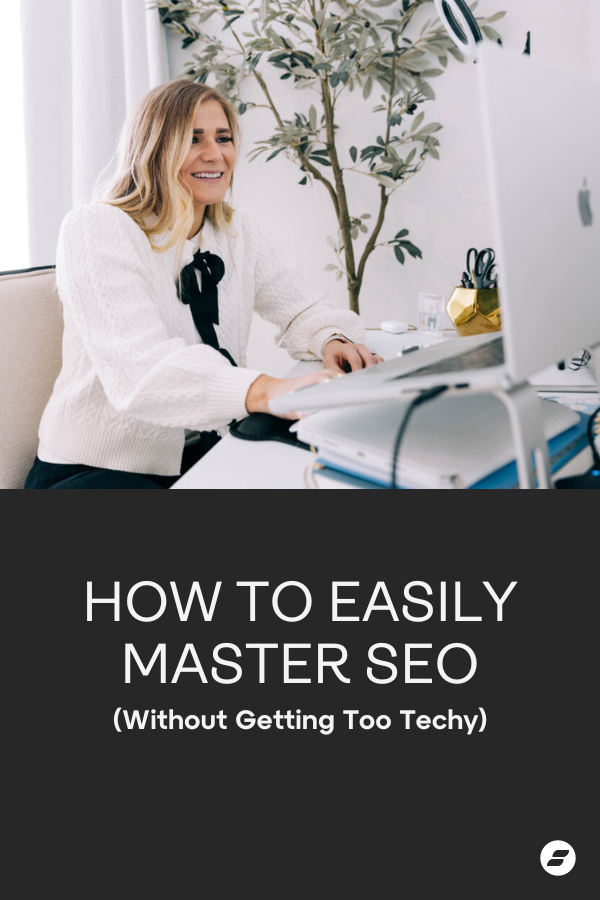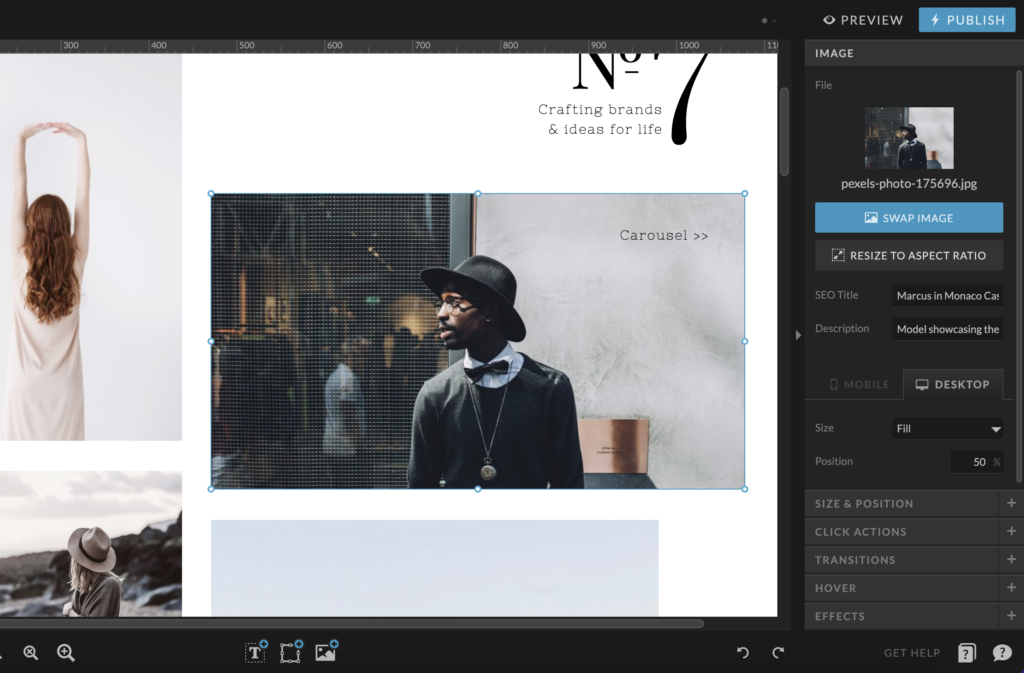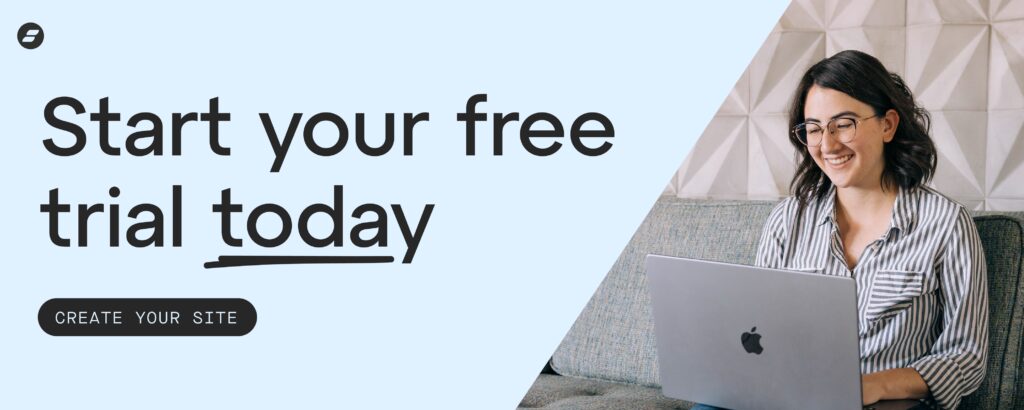So, you want your people to be able to find you online? Perfect. We want to help you optimize your website make that happen.
In order to get discovered organically—aka without spending a single dollar on paid advertising—you’ll first need to get acquainted with the concept of search engine optimization (or SEO).
We know that once acronyms get involved, things start to feel a bit overwhelming, but we promise: this introduction, and all of our SEO tips, are going to be easy to understand AND easy to implement.

What is search engine optimization?
SEO is the process of optimizing your website to rank higher in search engine results pages (or SERPs) for relevant keywords and phrases, to help your desired audience find you.
Simple, right?
In order to optimize your website’s pages for search engines to recommend your content to its users, all you have to do is improve the quality and increase the quantity of it.
So, let’s talk about exactly how you can do just that. 👇
Why should you bother caring about search engine optimization?
First, though, we need to discuss WHY you should even care about SEO in the first place.
The main benefit of SEO, of course, is getting yourself discovered. Prioritizing your content for search engine optimization is the best way to get your content in front of the right people. It’s a tool you never have to pay for, that never turns off.
‘Round the clock, day in and day out, your SEO efforts are working hard to show off your website’s pages to all of the people who are looking for exactly what you have to offer.
There’s also no expiration date on your SEO efforts, either. You could strike gold with one strategically-written blog post or webpage, and bring in consistent traffic to your website for years to come.
Another amazing benefit of optimizing your site for SEO—one that most people tend to forget about—is the credibility factor.
Think about the last time you searched for something. Which link did you click?
We’re willing to bet it was probably the first or second link, and if not, it was definitely a link from the first search results page.
Now, think about why that specific link was the one you chose to click, and how it impacted your impression of the brand whose website you landed on.
Of course you initially regarded that person as an extremely credible source. They’re on the top page of Google, so they must be trustworthy!

Every searcher has the same subconscious thought—because we live in such a digital-forward time, we’re so used to making judgments about brands within a nanosecond of interacting with them, and whether or not those first impressions last, they’re what can make or break your website traffic.
The higher you rank on Google, the better chance you have of the right person finding you, deciding you’re worthy enough, and clicking on you.
And, finally, “SEO will always be here,” according to SEO expert Stepfanie McCaffrey. “It won’t up and disappear like MySpace and your Top 8. … SEO won’t go out of style like skinny jeans and side parts, thanks to all the cool kids on TikTok. SEO will always be here, and other platforms are embodying this, too.”

It’s a very common misconception to think about SEO as something that’s only relevant to Google, when it’s actually relevant to your entire content strategy & digital marketing plan as a whole.
Other platforms now prioritize searchable content, by structuring their algorithms like the search engines do, so getting comfortable with the concept of optimizing your content for search capabilities is a smart move if you’re hoping for your brand to become more visible online.
Is SEO Worth It?
Considering that optimizing your website costs $0, has more lasting benefits than any other marketing tool, and gives you a reason to serve your audience and improve your credibility—yeah, it’s worth it.
RELATED: How Google Searches For Content & What That Means For Your Showit Website
What are the SEO basics you need to know, even if you’re not an SEO pro?
Now that you know why search engine optimization matters so much, it’s time for a brief overview of the SEO must-knows & SEO tips.
WEBPAGES
One of the most important things to note about SEO is that each individual page of your website has the opportunity to rank on Google—not your website as a whole.
This is great news! This means that you have endless chances for your ideal clients and customers to find you, and endless opportunities to show up in that #1 SERP spot we’re all chasing for.
KEYWORDS
And if you want to earn that #1 spot, you’ll need to know how to optimize your content for keywords.
But first, you’ll need to learn how to conduct keyword research.
A keyword is a word that “describes the content on your page or post best. It’s the search term that you want to rank for with a certain page. So when people search for that keyword or phrase in Google or other search engines, they should find that page on your website.” (Yoast)
Side note, speaking of Yoast: we highly recommend them as a great WordPress plugin for Showit users looking to optimize SEO on their blog posts! The plugin is SO easy to use, and makes SEO feel a lot more manageable.
Want to learn how to conduct keyword research for your website? Here’s our simple guide to it!
PAGE LOAD SPEED
How fast your website loads is one of the many things Google considers super important in determining whether or not they’re going to recommend their site to its users, because no one likes to wait.
Because Google prioritizes “page experience”—a set of signals that measure how users perceive the experience of interacting with a web page beyond its pure information value—making sure your website provides a positive experience for readers is key.
Here’s what Google considers a ‘positive’ page experience:
- Loads quickly on both desktop and mobile devices (does your site pass the mobile friendly test?!)
- Has a secure connection (is your site secured with HTTPS?)
- Has accessible content and has good visual stability (is your content accessible?)

RELATED: Google’s Core Web Vitals & How To Improve Your Showit Website
Ensuring your website is quick enough to please Google and your readers all depends on how much data has to be loaded before someone can browse the entirety of a given page.
While lots of things can affect a web page’s load time—embed code, text content, animations, etc—the biggest factor is often your website’s images. Here are our best tips for optimizing your images to improve page load speed!
And while we’re on the subject of how images affect speed…
OPTIMIZED IMAGES
The text content on your site isn’t the only thing search engines are interested in; images help your SEO a great deal, too.
Search engines love anything that makes your website more accessible, more appealing, and more engaging—because it means people will spend more time on your site, therefore solidifying the fact that their recommendation to send a user there was worth it—and that’s exactly what images can do.
Image SEO can also “make your content easier to interpret by search engine crawlers, which can give it an SEO boost on both search engine results pages and image results pages to make your site more discoverable.” (Hubspot)

METADATA
Two of the most important elements of SEO to master are SEO titles, and meta descriptions. These two elements make up your metadata, which is a type of on-page SEO that provides more info about a given web page.
Despite their techy-sounding names, they’re actually really easy to optimize, and really helpful for your readers when determining whether or not they want to click on something.
Your SEO title (or page title) tells your user and search engines the topic of a web page.
The meta description (or page description) describes the content of that page.
Here’s how those 2 elements of metadata show up when you Google Showit:

The blue text is our title tag—telling our readers (and the search engine!) what our brand is, and the gray text is our meta description (giving our readers more context, so they can determine whether or not they want to click on our homepage).
When writing your SEO title:
- Use a primary keyword (ours was “website builder”)
- Keep your length between 50-60 characters
- Don’t use generic titles; remember that your goal is to make people want to click!
- Use title case (and avoid writing in all caps)
And when writing your meta description:
- Keep your length between 140-160 characters to avoid being cut off
- Ensure the description is relevant to the title tag and the content of the page
- Only use keywords if it makes sense and reads like you would naturally speak; there are going to be real people actually reading them – no keyword stuffing!
The most vital thing you need to know about writing your metadata is this: NEVER DUPLICATE. Your SEO titles and meta descriptions are used to describe a given page of your website, not to be a blanket statement reused over and over.
Every page of your website is different, so every title and description of those pages should be, too. (Duplicate metadata will be flagged as an SEO issue and negatively impact your rankings!)
HEADING TAGS
HTML—or hypertext markup language, aka text tags—are Google’s signal to determine the importance and significance of a specific element of text on your website.
HTML tags are separated into 6 categories, from Heading 1 all the way until Heading 6.
“H1” headlines tell search engines “hey, this is a title, this is important!” — you’ll want to use this tag just once on each page, so search engines aren’t confused about which element of your site is the real title.
(In a search engine’s mind, the title is the most important element of the page, because it tells the reader what it’s about. It’s how they categorize the page in their giant “filing cabinet” of Internet content.)
“H2” tags tell them “hey, this is a subheading, it’s less important than the H1 but still a big deal!”
The HTML headings decrease in importance (in the eyes of search engines) as the numbers go on.
Bottom line: heading tags help search engines determine what is important on a page, and how they should categorize the content of a given page.
Here’s how to adjust your HTML and text tags in Showit!
CONSISTENT WEBSITE UPDATES
There’s not much search engines love more than a website with fresh, relevant content. And there’s not much search engines dislike more than a website with stale, unhelpful content.
Users and search engines alike want to know that your website is current and active, so they can determine whether or not your brand is trustworthy and worth investing in.
Updating your website on the regular—once a month is a good goal!—signals to search engines that you’re committed to providing your readers with the best possible experience, and that’s going to improve your chances of ranking higher on those SERPs.
Before you freak out, though, and start thinking “how in the world am I going to update my website copy once a month?!” – we’ve got good news: blog posts count.

We’re excited to tell you all about why blogging is so great for SEO and for building a relationship with your website’s readers in Part 8 of Showit’s Website Health Series, but for now, what you need to know is this:
Consistently updating your website by posting blogs gives search engines more pages to index (meaning more opportunities for your site to potentially rank #1!), and it gives you a chance to show off your expertise about your industry to your potential clients.
A win-win, if you ask us!
LINK BUILDING
Another techy-sounding-but-actually-easy element of search engine optimization to learn is link building. It’s an important part of having an SEO strategy that actually works, so you’ll want to take advantage!
Remember: search engines are all about making users’ lives easier, and recommending credible websites to the people who trust them to give good results. Links play a huge role in that.
There are 3 types of links you’ll need to care about to build a solid link strategy for SEO: internal, external, and backlinks.
Internal links (also known as inbound links) are links on your site that link to another page on your site.
Example: when we linked to our blog about Google’s Core Web Vitals & How To Improve Your Showit Website earlier in this post, that was an internal link. It’s a link from one place on our website to another.
External links (also known as outbound links) are links on your site that link to someone else’s website.
Example: when we quoted a Hubspot article earlier in this post, and shared the source with you, that was an external link. It’s a link from our website, to Hubspot’s website.
Having a healthy amount of internal and external links throughout your content both helps your user more easily navigate your site, and signals to search engines that you care about making your site more accessible for those users.
Backlinks are links to your website from other websites on the Internet.
Example: when Tonic Site Shop published a blog post about how to launch your Showit website, and included links to Showit.co, that was a backlink from their website to ours.
Think of backlinks like an element of social proof, made specifically for search engines to determine if you’re worth it.
You know how when you scroll through someone’s website, you look for a testimonial from a past client of theirs to see if they’re credible? Or how you scroll through Amazon product reviews before buying, to make sure the item is as good as you’re hoping it will be?
That’s how search engines view backlinks. The more websites that link to yours, the more credible search engines will think you are. In the search engine’s eyes, it's proof of your legitimacy.
QUALITY OVER QUANTITY
Although Google themselves have stated that word count doesn’t actually play a role in whether or not a page has the opportunity to rank, it DOES play a role in serving a specific audience.
Google’s John Meuller compares it to the differences in readers’ preferences: some people need a lot of information to understand something, while others only need the short-and-sweet explanation.
“If you have the information that you need for indexing, making it so users and Googlebot understands what [the] page is about, [and] what you’re trying to achieve with it in a short version, then fine, keep the short version.” — John Meuller, Google
But that’s not necessarily permission to always keep things short. Instead, it’s permission to write what you know your audience needs to hear; to put your readers above the algorithm in priority.

So, how do you know how long each page of your website (or blog post!) should be?
However long it takes for you to appropriately share the right information with your readers, in order for them to get a complete understanding of what you’re trying to say. If you’re able to give them all of the necessary context and details about a topic in 500 words, perfect—but you might find that, in some cases, you need closer to 2,000 words to get the job done.
Both options are acceptable, because Google is able to discern the fact that you’re sharing relevant content either way.
Let us break it down for you:
Google wants Sally to continue using its platform to search for the things she’s looking for. It’s in Google’s best interest to always give Sally the right content, so she’s a happy user, who wants to come back for more.
All Google cares about is serving Sally.
So, when determining what’s relevant to show Sally in terms of search results, Google is going to make its best effort to show her the things that she will find relevant, no matter how long or short it is.
Speaking of serving your audience…
Our #1 Best SEO Tip
When you’re writing content for your website, you’ll want to put your audience and yourself before the algorithm.
If everything you write feels authentic to you, and is engaging and relevant for your reader, you’ll automatically be serving the search engines, because the purpose they’re serving is making their searchers happy.
Thinking out of the box: how you can get discovered by the right people online
When it comes to optimizing your website and writing content for the purpose of helping your people find you online, the most important thing to consider is, of course:
What are they searching for?
When you stop focusing on how to get your brand’s name out there, and instead think about what your ideal clients and customers are already searching for and hoping to find—aka their search intent—you’ll notice that copywriting and content creation get a whole lot easier.
And it makes helping your people find you a whole lot easier, too.

Here’s an example of how you can put the concept of search intent into practice to strategically invite your ideal clients to your website. 👇
For the sake of this example, let’s say you’re a website designer, hoping to attract new clients to book out your next quarter.
You know that there are a lot of decisions that need to be made when launching a new website, from which website builder to choose, to which design style best fits the vibe of a brand—and as a website designer, you definitely have experience not only designing websites with different aesthetics, but also designing websites for a lot of different types of business owners. .
And because you know that your ideal client is likely considering which website builder to book before looking for their website designer—aka you!—you can help them with their choice by creating content about what you already know they’re searching for: which website builder to choose.
How easy would it be for you to gather your top 5 best websites you’ve designed on Showit, write a few sentences about why the platform is so great for creatives, and then compile everything into a blog post with a nice, clear call to action about your design template customization services at the end?
Pretty easy, right?
There’s an extremely high chance your ideal clients are going to search for (and read!) a blog post that answers their burning questions, gives them much-needed inspiration, and helps them make a decision they’ve been struggling with—and that’s where you come in to save the day, show off your value & expertise, and make a great impression.
And from there, the obvious next step will be for them to explore your services, and book you! Whoot!
Ready to Learn More About SEO?
🔘 Write to Delight Readers and Seo with Showit Design Partner Gillian Sarah
🔘 Listen your way to great SEO with Showit Design Partners Grace and Gold
🔘 Watch SEO Expert, Ryan Moreno of Tonic Site Shop, longtime Show Design Partners, drop a huge amount of knowledge in this webinar…
Now that you know how to help people find your site, you’ll need to make sure they like what they see when they get there.
Head over to Part 5 of Showit’s Website Health Series to learn how to write the best website copy, so that when your ideal clients land on your website, you’ll actually be able to convert them into buyers!

Chris is multitalented, being able to play a number of instruments, and having an inclination towards creative design, AND technical know-how. He cheerfully brings his Swiss army knife of skills to our designer community.

